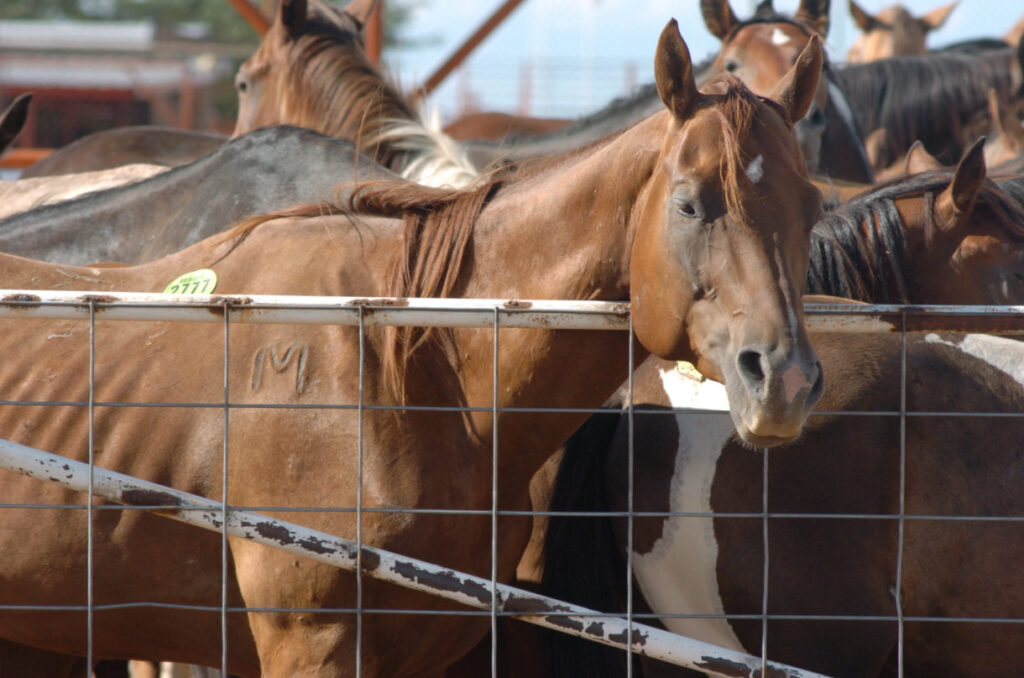 Some time ago, we visited the subject of horse slaughterhouses in the United States. Since then, there have been some recent developments of which every horse owner should be aware.
Some time ago, we visited the subject of horse slaughterhouses in the United States. Since then, there have been some recent developments of which every horse owner should be aware.
Granted, the issue of horse slaughter is often hotly contested and emotions run high on both sides of the debate. There are pro’s and con’s to both arguments and the strong feelings on both sides of the fence are clearly reflected in the political climate.
More than a decade ago, horse slaughter plants in the United States were basically forced to close after Congress passed a bill which stripped funding for U.S. inspections of those slaughterhouses. While the measure did not ban slaughterhouses per se, the effect was the same.
Without that crucial federal funding for inspections, the plants were forced to close. Since that time, this ban, in one form or another, has been reintroduced and passed regularly by the House and Senate Appropriations Committees, and legislation has effectively kept horse slaughterhouses from operating in the United States.
For those unfamiliar with the workings of congress, the Appropriations Committee of the House and Senate are accountable for the responsible and limited levels of federal discretionary spending. In laymen’s terms, these committees basically decide how the U.S. government should spend “extra” tax dollars and they do this by passing “appropriations bills.”
These bills, to become law, must be approved by a majority vote in both the House of Representatives and the Senate Committees on Appropriations.
Earlier this year, Representative Lucille Roybal-Allard (D-CA), joined by Charlie Dent (R-PA) presented a bi-partisan Bill to renew the effective ban on U.S. horse slaughterhouses to the House Appropriations Committee. After heated debate, the Bill was defeated by a narrow 27-25 vote. This essentially paved the way for the re-institution of horse slaughterhouses within the United States. After passing through the House by a slim margin, in July of 2017, the Bill moved on to the Senate Committee.
The Bill, however, received a much different reception in the Senate. Senators Tom Udall (D-NM) and Lindsey Graham (R-SC) led the bipartisan effort to keep the effective ban on slaughterhouses, and the bill, co-sponsored by a number of other committee members, passed through the Senate.
The House and the Senate are obviously in disagreement and the issue, therefore, is currently in limbo. The question will need to be determined by lawmakers at a later date.

American horses are held in export pens in Texas and New Mexico before transported to slaughter in Mexico.
The idea of equine slaughterhouses in the United States has been slow to gain traction because many Americans do not see their horses as livestock, but rather as companions and pets. They would no sooner send their horse to slaughter than they would their dog or cat. In fact, opponents of horse slaughter plants have consistently pushed for a permanent ban on the killing of horses for human or other consumption (one that is not based on the funding of inspections, but rather on an outright prohibition of the practice), which would also include a prohibition on the export of American horses to foreign slaughterhouses. This measure, termed as “SAFE” (“Safeguard American Food Exports”) has gained political momentum, including the support of some republicans. In addition, many fear that permitting horse slaughterhouses to operate in the United States would lead to unscrupulous practices involving horse auctions and sales; such as well-funded slaughterhouse buyers coming in and easily outbidding rescuers and other legitimate buyers in order to obtain prime horses for slaughter.
While the opposition to horse slaughterhouses is understandable, the ban on slaughterhouses leaves unanswered concerns regarding unwanted horses. Horses get old, get sick, become lame, become financially burdensome, and owners, as well intentioned as they may be, are simply unable to care for them. Many areas of the country do not have a sufficient number of horse rescues, and the horse rescues that do exist are quickly becoming overcrowded.
Currently, owners can get $700, or more, for selling an unwanted horse to a foreign slaughterhouse across the border or even overseas. In contrast, euthanizing a horse and disposing of a horse carcass by bringing it to a landfill (assuming there is such a landfill willing to accept the carcass) can cost an owner several hundreds of dollars. In addition, cremation can cost $1,000 or more. Given the costs and the lack of viable options, many owners do choose to sell their horses to foreign slaughterhouses. The problem is, the shipment and treatment of horses in slaughterhouses outside the United States is largely unregulated and the horses are generally subject to conditions most Americans would consider deplorable and excessively inhumane.
So, where do things go from here? A look at the current political climate may give us a glimpse of how the issue may likely be determined in the future.
The Obama administration was adamantly anti-slaughterhouse and the effective ban on slaughterhouses was secure during that administration. However, the current Trump administrations appear to be more open on the issue.
Current House Speaker Paul Ryan voted against the slaughterhouse ban in 2006, and continues to be a proponent of U.S based horse slaughterhouses. The Trump administration has recently considered the sale of wild Mustangs in the United States. Mustangs, while a beloved symbol of the American West, are estimated to cost taxpayers approximately 50 million dollars a year. The Trump administration has proposed that lifting the ban on the sale of wild Mustangs to slaughterhouses outside the United States would not only reduce the cost to taxpayers but also raise an additional 10 million dollars in revenue. This might suggest that the current administration may also see the value of reinstituting horse slaughterhouses within the United States.
In addition, subsequent to the House Appropriations Committee vote, reportedly two slaughterhouse opponents have left the Committee and three pro-slaughterhouse lawmakers have joined.
Therefore, based on the current climate, and based upon the past vote of the House Appropriations Committee, even if the effective ban on horse slaughterhouses stands through the current year, when the issue comes up again it may very well be defeated by an even wider margin.
One thing that seems to be certain is that there are changes potentially on the horizon and whether you are for or against equine slaughterhouses, it is a situation that needs to be monitored closely.
Mati Jarve is the managing partner of the Marlton, New Jersey law firm of Jarve Kaplan Granato, LLC. He is certified by the New Jersey Supreme Court as a Civil Trial Attorney and the National Board of Trial Attorneys as a Trial Advocate. Licensed in New Jersey, Pennsylvania and Arizona, he maintains a national practice in civil litigation, including equine related issues. This article is for informational purposes only and is not intended to be legal advice.
If you have a specific legal question or problem you should consult with an experienced and knowledgeable equine law attorney. Questions, comments or suggestions can be e-mailed to mjarve@nj-triallawyers.com, by visiting www.nj-triallawyers.com.



You must be logged in to post a comment Login